

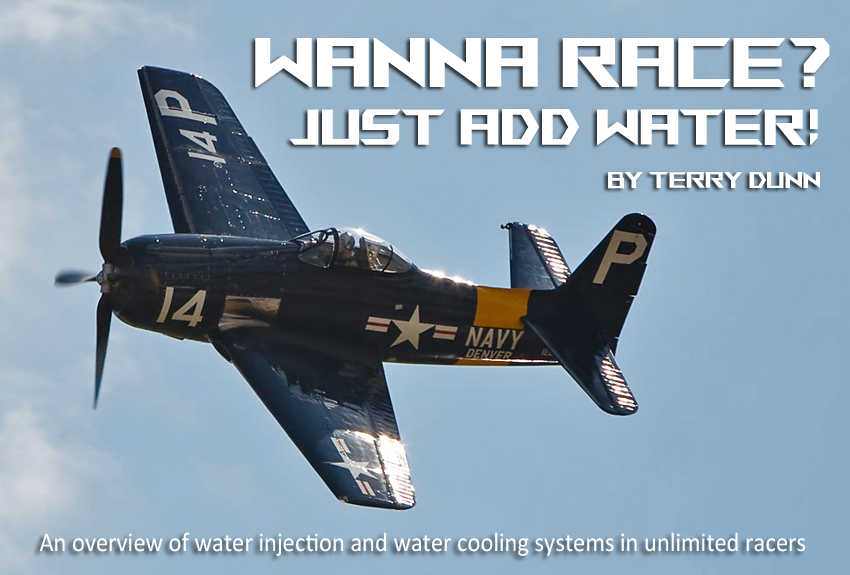
This article was originally published at Tested.com. It is republished here with permission.
Unlimited-class air racers are truly awesome machines. This brand of racing is dominated by privately-owned, 70-year-old fighter planes. The most successful racers abandon the historical significance of their steed, replacing drab military colors with dazzling paint jobs and spending countless hours (and dollars) massaging every part for minimum aerodynamic drag. The souped-up engines in these racers are often just as old as the airplanes themselves. Yet, they are routinely pushed to crank out as much as double power that they were originally designed for.
It takes a lot of fuel to feed these antique, gargantuan engines as they belch out 3,000-4,000 horsepower. In fact, the average unlimited racer will burn a gallon of super-high-octane, race-blend AvGas every 8.5 seconds. The only way that these engines are able to sustain such high power output over the entire span of an 8-minute race is to consume another vital liquid in even larger quantities. So what is this top-secret, go-fast, miracle concoction? Water.
To put the 7-gallon-per-minute fuel consumption of a racing engine into perspective, I measured the flow rate of my 3/4"-diameter garden hose. It could do no better than 6 gallons per minute. While a racer's fuel tanks are practically hemorrhaging their highly-refined life blood, water tanks on the airplane are draining even faster...nearly 12 gallons per minute! The water is pumped to destinations both outside and inside the engine's combustion chambers. Without an ample flow of this most basic of liquids, unlimited racers would not be able to skim the desert outside Reno, Nevada at nearly 500 miles per hour...not even close.
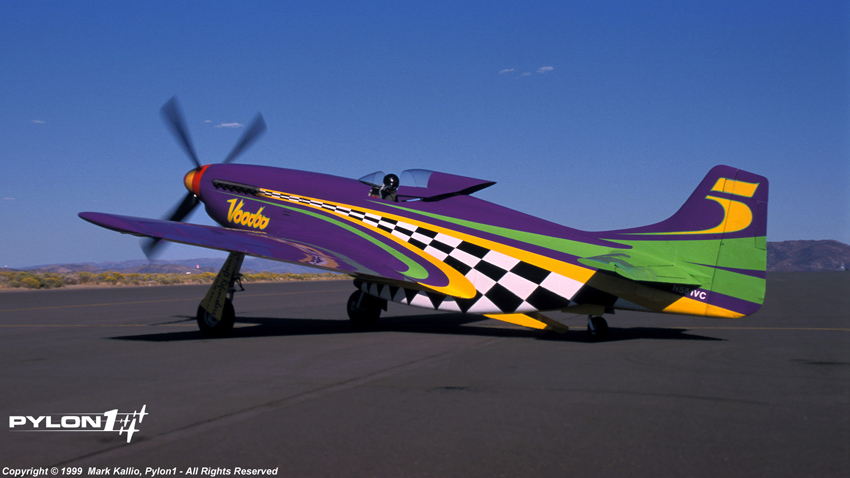
The Law of Water
Most modern water-based cooling strategies for race planes can be attributed to one man, Pete Law. He's been helping race teams understand the benefits of water ever since the National Air Races became anchored in Reno in 1964. When I recently spoke with Law, he was nearing his 80th birthday. At an age where less-driven men might look forward to a game of shuffleboard or an afternoon water-aerobics class, Law remains a permanent fixture of the racing scene. He isn t just a water guy at Reno. He's the water guy...and his know-how is sought by nearly every unlimited-class contender.
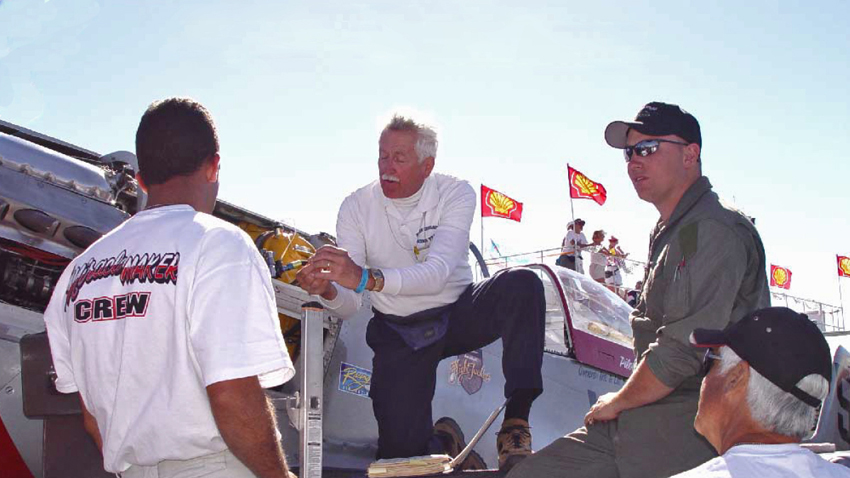
Nobody seems to mind that Law's services are available to anyone who asks. It is widely accepted that he doesn t play favorites. Nor does Law charge the premium that his expertise could justifiably demand. After all, he's not in it for the money. For most of his career years, Law's work with racers was a sideline gig. His "day job" was as a thermodynamics engineer at Lockheed's famous (but uber-secretive) Skunk Works, where he worked on aircraft such as the U-2, SR-71, and Stealth Fighter. Those are just a few examples pulled from the high-profile projects that he's privy to talk about. Many more remain cloaked behind decades of well-rehearsed silence.
Law's career immersed in national secrets somewhat mirrors the clandestine nature of the pits at Reno. The atmosphere is friendly. But racing is racing...and nobody wants to spoil a shot at victory by leaking the details of their latest speed-enhancing gimmick. There is never any question that privileged information about a given airplane is safely tucked away in "Secret Pete's" vault when he steps away to work with other teams. He treats each of his clients with all the discretion of a Swiss banker.
Play Misty For Me
There are two basic types of engines used in the unlimited class: liquid-cooled V-12s and air-cooled radials. While there isn t much commonality between these engines, one thing they share is a need to cool down the oil that lubricates them. To do this, the oil is pumped through radiators. Just like the cooling system on your car (assuming, of course, that you don t drive a Corvair or an old VW), air passing through the fins of the radiator carries away heat energy. High-output racing engines generate gobs of hot oil, so it would be logical to assume that they also require large oil radiators. While that is theoretically true, every square inch of radiator that is stuck out in the cooling breeze only adds to the nemesis of air racers: aerodynamic drag. Let s not forget that drag increases as the square of velocity. So there is a huge incentive to make radiators as small as possible.
Law initially found success using "boil off" oil cooling systems, where the oil radiators were immersed in a bath of water. Heat energy was pulled from the oil flowing through the radiator to literally boil away water over the course of a race. These days, most Law-designed oil cooling systems utilize a spray bar. This device shoots a continuous mist of water onto the surface of the radiator, greatly increasing its ability to shed unwanted heat.
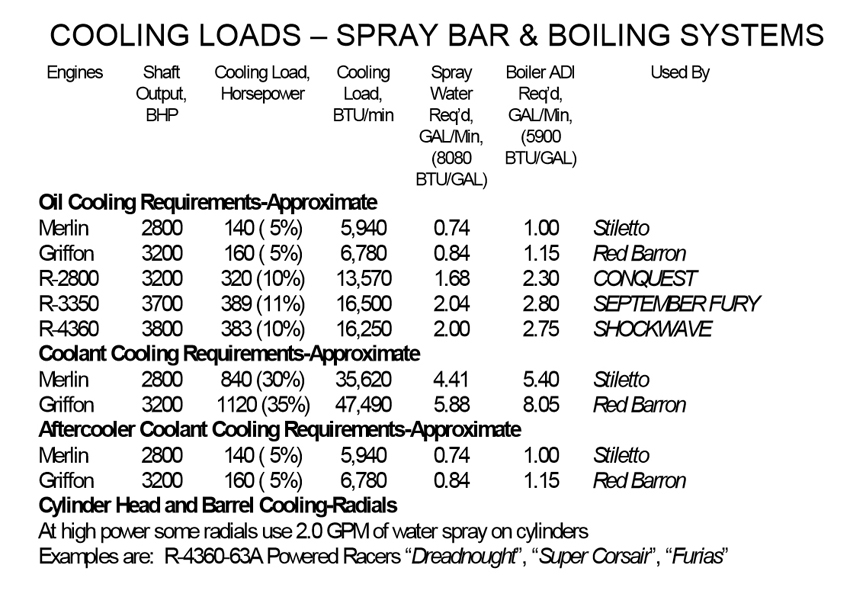
In addition to oil coolers, the big V-12 engines also have substantial radiators to manage the glycol/water coolant mixture that is pumped through the engine block to control its temperature. Spray bars are still the preferred method to keep the coolant radiator(s) as small as possible. The water nozzles sometimes spout more than 5 gallons per minute onto the radiator to keep coolant temperatures in check.
The dominant V-12 engine at Reno is the Packard-built Rolls-Royce Merlin found in P-51 Mustangs. The cornerstone of the P-51's success in war and on the race course is the Merlin s 2-speed, 2-stage supercharger. The prime benefit of the supercharger during WWII was that it allowed P-51s to sip fuel while flying in the rarefied air at high altitude and provide escort to vulnerable bombers on long-distance missions.
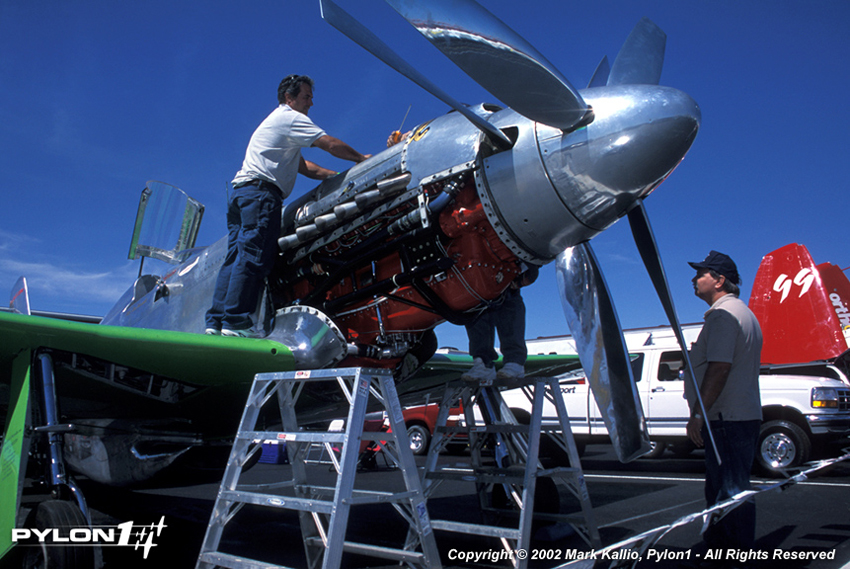
While skimming the ground during an air race, the same supercharger can shove air into a Merlin at more than four times the atmospheric pressure found at sea-level. More air coming in means the engine can burn more fuel...and that means more horsepower. The question then becomes, "How much power can the engine produce on the race course without blowing itself apart?" Pushing the engine just a little harder with more supercharger boost (i.e. manifold pressure) could put you ahead of the pack, or it could be the catalyst for a busted engine and a dangerous emergency landing.
One of the primary risks with generating high manifold pressure is that the fuel-air mixture is intensely heated as it is pressurized by the supercharger. The Merlin features intercoolers located after each stage of the supercharger help to reduce the temperature of the mixture and prevent it from burning before it's supposed to. Called "detonation" or "knock," such unintended explosions can destroy an engine in dramatic fashion. As with the other cooling devices, the intercoolers need an extra boost to handle the rigors of racing. Spray bars are, once again, a simple and effective solution.
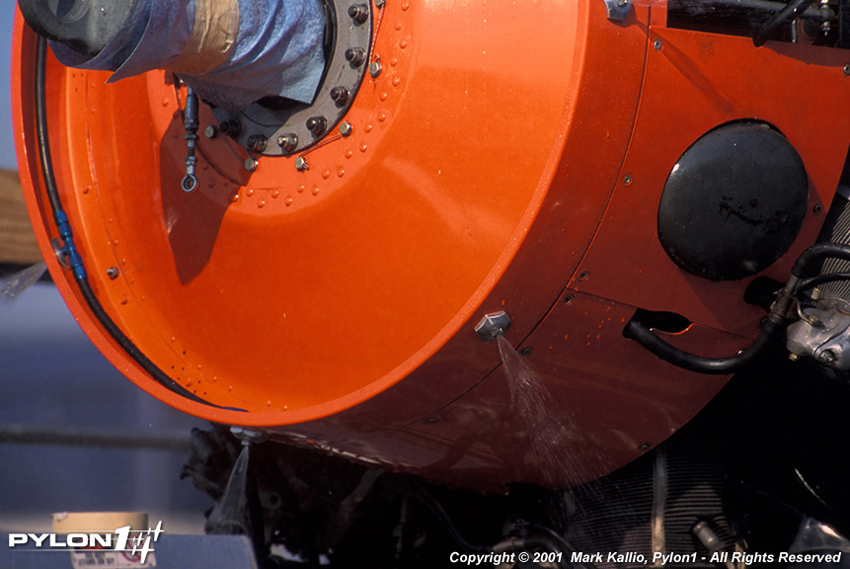
Lacking liquid coolant and the requisite radiators, air-cooled radial engines are inherently less complex than the V-12s. Yet, the challenge of preventing these round-faced engines from overheating is equally daunting. Air-cooled engines rely on air passing over their finned cylinders to pull away excess heat. Managing this cooling process in a racer requires a delicate balance between safe operating temperatures and the aerodynamic drag created by air flowing over the engine.
Compared to their wartime ancestors, radial-powered unlimited racers have impossibly small slits for cooling air to enter the engine cowling. For instance, the massive Pratt & Whitney R-4360 engine has a diameter of 55 inches. Yet the area where cooling air enters on race planes, a gap between the conical propeller spinner and the cowling, is a ring measuring just 1.5 to 2 inches wide. The cooling efficacy of the sliver of air passing through this gap is maximized by meticulous baffling that directs flow precisely where it is needed. Of course, the situation is vastly improved by circular spray bars that mist water onto the outside of the engine.
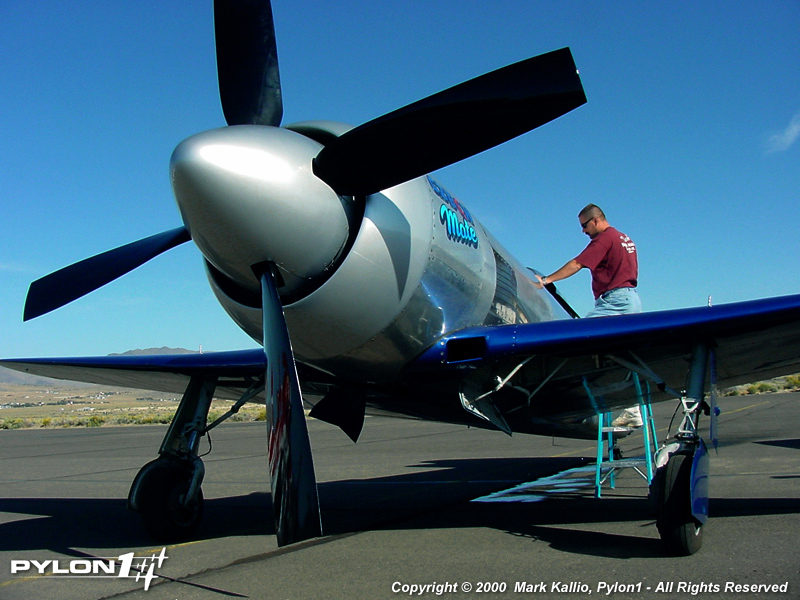
Fahrenheit 4500
It is generally accepted that allowing water to get inside of your gasoline engine is a bad thing. If you re unsure of the consequences, just ask someone who has unsuccessfully attempted to drive their car through high water. Private pilots will tell you that one of their preflight rituals is verifying that their airplane's fuel tanks have not been contaminated with water. Given those examples, it may come as a surprise to learn that ingesting water under the right conditions can actually improve the performance of a piston engine...a lot.
The basic idea behind water injection is quite simple. If you understand why steam burns on your skin are so painful and damaging, water injection utilizes the same principle in reverse.
Water mist is injected into an engine's supercharger along with the fuel/air mixture from the carburetor. This water/fuel/air cocktail is homogenized as it is pressurized in the supercharger. The mixture becomes heated as it is pressurized and by subsequently passing through hot engine components. This elevated temperature of the mixture eventually causes the water component to change phase from liquid to gas. You may recall from high school chemistry that the water must absorb a tremendous amount of heat energy (latent heat of vaporization) to complete the phase conversion. That heat energy is pulled from the surrounding fuel, air, and engine parts...thus reducing their temperatures. Given that the burning fuel in the combustion chambers of a racing engine can reach about 4500 degrees Fahrenheit, shedding heat is mandatory to prevent total meltdown.
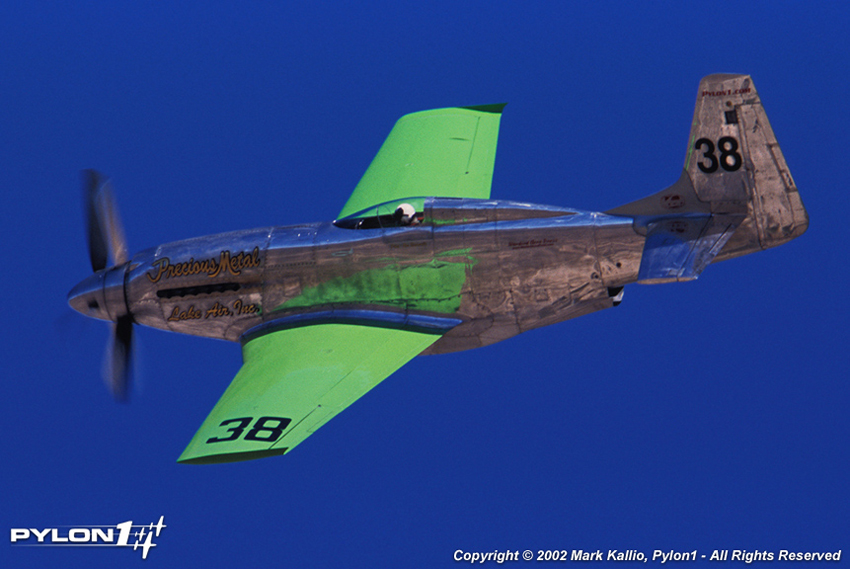
One source notes that when water injection was incorporated on the Pratt & Whitney R-2800 radial engine during WWII, the temperature of the fuel/air mixture entering the engine cylinders dropped from 350-degrees Fahrenheit to just 100-degrees. Such temperature reductions afforded by water injection allow engines to be run at much higher horsepower settings before detonation becomes a concern. Again, the R-2800 provides a convenient example. Although rated to produce 2,000 horsepower, Pratt & Whitney engineers were able to reliably coax 3,800 horsepower out of the engine when using water injection in lab conditions. Even seven decades later, pilots at Reno are pushing R-2800s somewhere north of 3,000 horsepower.
Piston airplane engines do not have a monopoly on water injection. Some jets also use it to reduce engine temperatures when under heavy load. There have even been a handful of production cars with factory-installed water injection systems. However, Law explained that water injection is usually of little value unless you intend to push an engine to its limits.
During wartime, pilots often had reason to push their engines. Water injection was used in those moments where a brief kick in the pants (i.e. War Emergency Power) could get a pilot out of a sticky situation. The tanks containing water injection fluid were usually only large enough for a few minutes of usage.
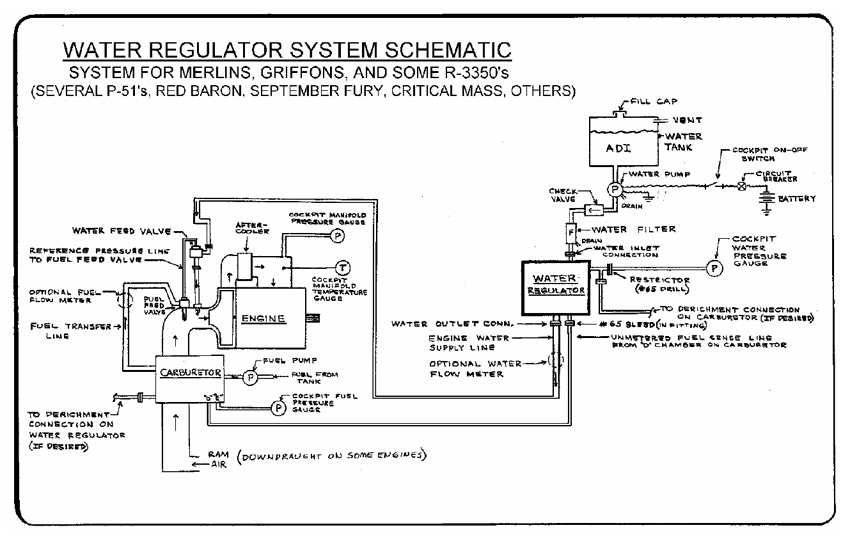
Water injection systems are often called Anti-Detonation Injection (ADI). While water can be used "neat," it is most effective in airplane engines when cut with an equal volume of methyl alcohol (methanol). When ADI systems were first implemented in US warplanes during WWII, the necessary type of alcohol was not adequately communicated to front line units. Told only to mix alcohol with water, crew chiefs in the field made ADI fluid using alcohol that they had available, the isopropyl alcohol that was also used to de-ice airplanes. That communication oversight resulted in numerous destroyed engines and nearly caused the entire fleet of P-47 Thunderbolt fighters to be grounded.
The water side of ADI fluid is not as critical. Law states that Reno tap water works just fine in this application
All of the radials and V-12s that Law works with today had factory-installed ADI systems when they were originally manufactured. Yet, parts for the V-12 ADI systems are tough to find these days. Law relates that this is because most post-WWII military and commercial piston-engined aircraft used radial engines, not V-12s. Consequently, most of the racing ADI systems that Law designs for unlimited racers, whether V-12 or radial-engined, utilize a water injection regulator pulled from an R-2800.
Many of the same types of aircraft that make up the unlimited racing class can also be seen in private hands as "warbirds." These versions are more historically accurate, but do not usually participate in air racing. Law conveyed that pilots of these airplanes rarely engage their water injection systems. He attributes that trend to the extreme fuel costs associated with running at high power settings, as well as a desire to baby the engines in order to extend their useful life between very expensive overhauls.
Finish Line
Winning an unlimited-class air race requires a long list of elements. Many of those necessities are apparent: a small airplane with a big engine, plenty of gas to keep it running, and a gutsy pilot to fly low and fast enough to kick up a sandstorm. Yet, all of those big-ticket items are meaningless unless paired with plenty of that free magic potion that keeps things cool: water.
Bibliography/Suggested reading:
Reno for Gearheads by Graham White
Engineering Reno's Unlimited Racers by Peter Law and Dan Whitney
How Reno Racers Keep Their Cool , by Preston Lerner, Air & Space Magazine, September 2012




